Blockchain in agriculture: a guide for farmers
Last year, Mikhail Shlyapnikov turned to Emercoin, head of the Kolionovo farm, which has now become the first farmer in the world to successfully use the blockchain in agriculture . Today, Emercoin and Michael are increasingly receiving questions: “How to use blockchain in agriculture? Where to begin? Will blockchain be beneficial for me? " etc. Relying not on theory, but on practice, the Emercoin team created step-by-step instructions for using blockchain technology for farmers.
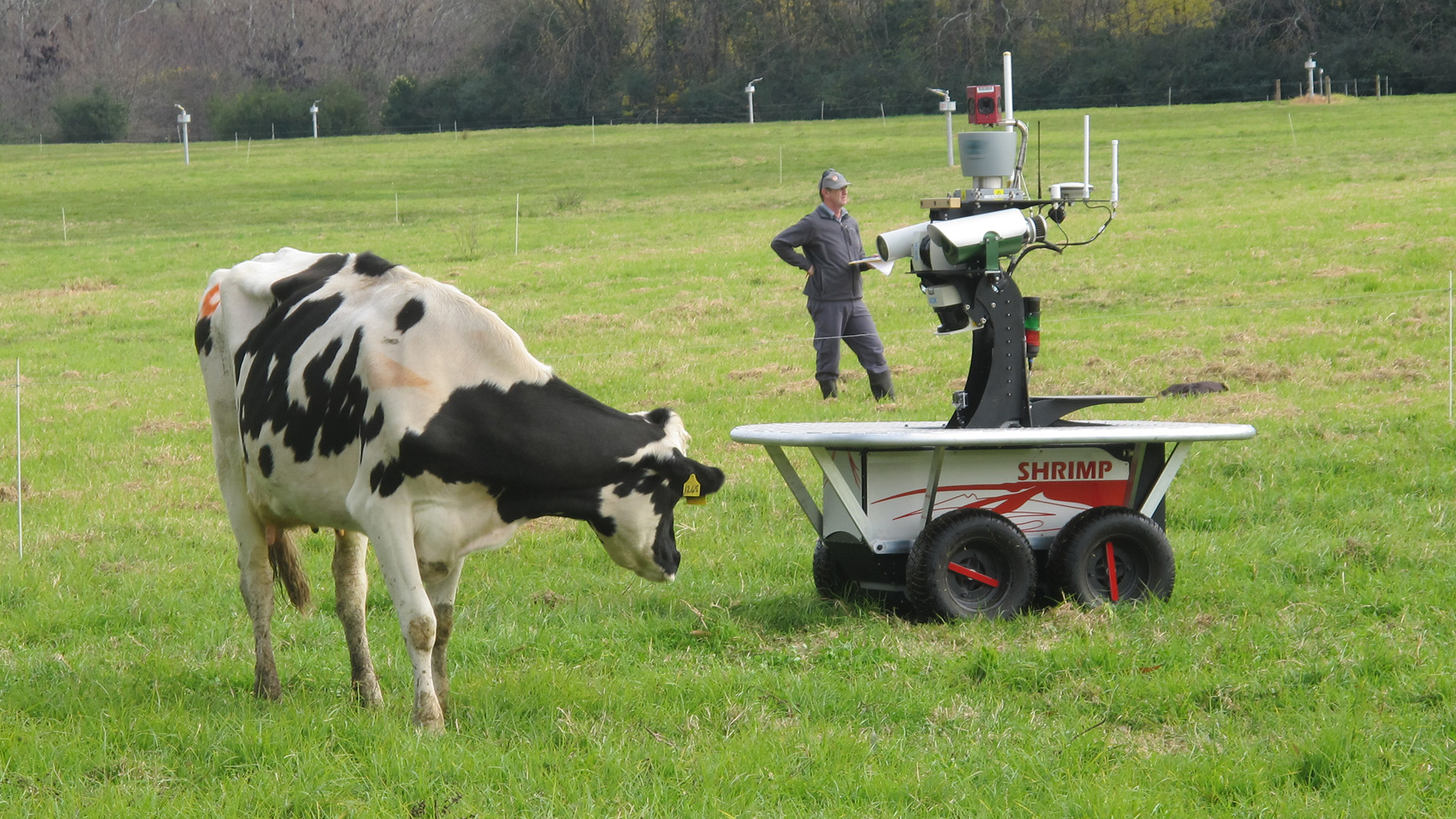
With blockchain, the future of agriculture is a little closer
Imagine a big beehive: queen bee, drones, scouts, worker bees. Everyone has their own tasks, but the mission is the same: honey! As much honey as possible! Add to this scheme an observer who will record: which bee from which flower how much pollen or nectar has transferred to the hive. Time, grams, the type of flower and its location data on the meadow - everything is taken into account.
In essence, the blockchain is the same. A large database hosted on the network and accessible to a huge number of users. It is with the consent of the latter that all data is entered into the database.
In addition, once recorded information cannot be changed or erased. This system allows you to store money and important documents, track transactions and transactions, as well as independently, without intermediaries, carry out cash transactions.
')
But unlike the hive, where there is a queen and a beekeeper, there is no “upper power” in the blockchain. The interference of the state and officials is ruled out here.
Returning to our analogy, we repeat: the blockchain is a glass hive in which each portion of nectar or pollen brought by different bees is visible. But only the owner of the hive, the owner of the blockchain entry, can take the sweet honey. The main properties of this technology: publicity, distribution and mathematical accuracy. Another important detail draws attention to itself: if we talk about money transactions based on the blockchain, they are made only with the help of cryptocurrency. Doubt that cryptocurrency works for real? In vain. Details on how effective this "monetary unit" can be found here.
Indeed ... They lived for so many years without him! But even at the splinter, they used to live, and rye was harvested without harvesters, and they also somehow managed to do without telephones. However, progress cannot be stopped, and the blockchain is gradually gaining confidence. You need it or not - decide for yourself. The possibilities of using the blockchain are endless, its functionality depends only on your imagination. The most important thing is to understand the basic principles of work and understand the advantages of using this system. We will give a few examples of the possible use of the blockchain in agriculture.
Suppose you grow and sell seedlings of fruit, coniferous, ornamental trees, berry bushes. In most cases, sales are seasonal and take only a few months, the rest of the time is planting and caring for plants. But money is needed all the time. Using the blockchain, you can create an optimal system of settlements with customers. For example, payment upon purchase is replaced by an advance payment. Such calculation is even beneficial to the customer, because, firstly, it assumes a discount, and secondly, each installment system calculates, based on its own capabilities and in accordance with the agreement.
Buying trees and shrubs does not belong to the category of spontaneous purchases. Landscaping begins to think when they buy a plot or start building a house. Everyone understands that trees need several years to grow. Your customer can choose the necessary trees from the range offered to him, watch how they grow, paying you advance payments.
Why do we need a blockchain here? For your convenience and for the peace of mind of clients who are confident in this case that all the conditions of the order will be fulfilled. Given that you do not connect lawyers who help draw up a contract, do not take receipts that are easy to lose. You simply make a record of the transaction concluded with the client in the blockchain. This entry can be seen by all network members. Therefore, to deceive any of the parties will not succeed. The system completely eliminates dishonest transactions.
Payment terms you negotiate with the client separately. For example, you have agreed that the customer makes advance payments monthly. Then every month, at the agreed time, cryptocoins will be sent to your wallet from the client, which you will transfer to real money.
Cryptocurrency is one of the important conditions of the blockchain. When you install the blockchain on your computer, you start a virtual cryptocell.
How is the transfer of money from one wallet to another? If you compare with something familiar, then submit an email. From your mailbox you send a letter to another recipient. Now we completely eliminate the function of sending the same message to several recipients and replace the letter with a cryptocurrency. For example, user N sends to user M - 4 EMC. (EMC is a type of cryptocurrency, at the time of writing the material its cost was 11 rubles 28 kopecks)
This transaction will include two components:
The amount is the number of coins that user N sends to user M.
The output is the address of users N and M, and the time of departure.
That's all. This information is now neither deleted nor changed. Money transfer is perfect.
If you think that among your clients there is not a single person who wants to make transfers in cryptocurrency, then we can assure you that you are in a hurry with the conclusions. There is no need to go far for a real example. On the eve of the New Year, Mikhail Shlyapnikov was selling Christmas trees for the emmercoins. Depending on the breed, variety, quality and height of the tree, the price ranged from 150 to 350 EMC. An ordinary market price in rubles was taken as a basis, but with a discount, since Michal did not spend money either on the supply of Christmas trees or on sellers. The conversion to cryptocurrency occurred at the average exchange rate at the time of purchase. Buyers did not have to wait long. The demand was not joking.
If, however, the calculation in cryptocurrency is inconvenient for you and your customers ... We offer another way to interact with customers, based on the blockchain platform. He effectively works in Kolionovo.
Mikhail Shlyapnikov on the blockchain registered 50 shares. Simplifying the explanation to customers, calls them a kind of wallets. When you purchase a wallet, you automatically receive a share of Kolionovo farm. There is one colony in this wallet - a conditional, but hard currency, invented by the farmer himself. It is not tied to the ruble or the dollar, but to a specific basket or a separate set of products.
The farmer sells these wallets for services or rubles. The cost of one wallet is 24,000 rubles.
The customer chooses, for example, the pond stocking basket and buys a wallet. The customer invests in stocking carp pond, and the farmer performs all the necessary work. Further, depending on the agreement, the client is either paid dividends from the sale of farmed fish, or the goods are given - in this case, carps. By the time the carps grow up, and the final calculation will be made. For their 24 000 rubles, the client will receive more than 100 kilograms of fresh fish! And if this amount of product he does not need? One does not eat as much, and other types of sales are not suitable for the client - what to do? As a rule, a farm has always something to offer - seedlings or potatoes, chickens, eggs, quails or milk, pork or beef, etc. Since the client is the owner of the unit, he will receive any products chosen by him twice cheaper. Profitable? Sure! A new production module is formed, which will “feed” other people - the purse owners who have invested not in stocking a pond, but in an apiary, a compound feed workshop, raising sheep or producing eggs.
Each owner of the wallet, while they are in Kolionovo 50, has fish, meat, eggs, milk, and vegetables. According to Mikhail Shlyapnikov, only six months have passed since the project started working in real mode, and it turned out that the cost of production has sharply decreased. This allowed to provide customers with substantial discounts (up to 40%), while not going beyond the framework of profitability.
Is it possible to apply the same system of shares without expanding your farm? Suppose you have a small agricultural production: two cows, a dozen hens, a few rabbits. You sell eggs, milk, sour cream, yogurt, sometimes meat. Expand their possessions do not want or can not for some reason (lack of large territory or labor). Instead of several baskets offered by Michael, you can stop at one - grocery. Act in the same way. Register in the blockchain unit wallets, the number that you deem necessary. Sell them for rubles. For example, your wallet will cost 30,000 rubles. For this amount you provide your customers with a grocery basket that includes: two hundred eggs, ten liters of milk, 5 liters of yogurt, 4 rabbits. This basket client can receive a one-time, or to stretch the receipt of products for a whole year.
The proposed use of the blockchain by Mikhail Shlyapnikov came up with quite recently.
Suppose you live in the Krasnodar Territory, Dagestan, Georgia, France ... Where weather conditions allow you to grow grapes and produce wine. Planting and harvesting, preparing pulp and wort ... - the technology of your work remains unchanged, but now you supply each barrel or bottle with an individual certificate and a QR code. Photograph and send to the cellar. Then make an entry in the blockchain, release the asset and place it at the starting price on a cryptocurrency exchange. Michael called such assets alco-colonies.
Why do you need it? The fact is that derivatives based on cryptocurrency are in great demand now. Traders will use your asset as a speculative derivative. A derivative is a tool that allows investors or traders to trade an asset indirectly - that is, not by the asset itself, but by any kind of obligations to transfer it or value units created on its basis, in our case, the obligation to transfer wine. The most common derivative is futures. This is a contract for the purchase of goods in the future, at a price that has already been established. This allows the buyer to insure against excessive price increases - but it means additional costs in the event that prices for goods decrease. But you as a manufacturer are not interested in the rise or decline of prices, since you are lining up in the starting amount all the costs that you will have to spend.
In the same way, it is possible to produce assets for breeding geese, rams or rabbits. For example, you make an entry in the blockchain and release assets for the purchase of geese in 2018. With the money received from the sale of assets you buy eggs, animal feed, pay for the light, materials, repair the roaster, and by 2018 you will already be ready to give the geese.
And what exactly do you need to do?
First, be patient. Any innovation is always difficult. Worldwide, large manufacturing and small enterprises, central banks, young startups and farms are choosing blockchain as the fundamental basis of their own business.
Secondly, you need to decide which of the functional solutions of the blockchain is necessary for your business. We have listed only a few examples of using Emercoin blockchain in agriculture. You can apply them all or come up with something of your own - blockchain technology is multifunctional.
If you decide to register the shares on the blockchain, then we offer you step-by-step instructions. First you need to understand that registration of units requires a special DPO-record. What it is? A DPO record is a record of a unique name on the blockchain, signed by another name, hereinafter referred to as “root”. For example, the root is the name "dpo: Kolion", which is owned by Mikhail Shlyapnikov.
By signing with this name the units of his household, he certifies that it was he who released them, and no one else.
Understanding is, great. Getting to work.
1. Download and install Emercoin wallet. This can be done on the official website of Emercoin, by going to the wallet-download tab. Downloading and installing the wallet is literally two clicks, so it does not take much time.
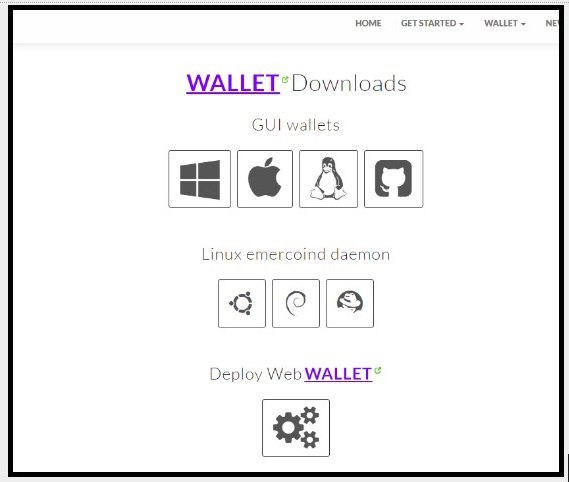

After downloading the wallet. Perform standard program requests.

It will take a little time for the wallet to synchronize with the network.

2. Next, you need to replenish the wallet cryptocurrency. To do this, go to one of the many exchanges and exchange real money for EMC coins. For example, this can be done on the exchange: LiveCoin, or on any exchange from this list. You can also ask for some coins from the Emercoin team.
To get the initial shares you need no more than 10 EMC. Translated into rubles, this is a little more than 120 rubles.
3. Then proceed to create the root record. Open the wallet and find the tab "Manage Names" in the wallet.

Create a new root name with the service prefix "dpo:". For example, the name “dpo: Kolion” was created for the agricultural enterprise “Kolionovo”, and for the “Rocket” watch factory “dpo: Raketa”. You need to insert the name of your organization in the name line. As an example, we will call our agricultural enterprise “Romashka”.

Next we fill in the value field. In it we enter any information that we want to report about the company. The information must be entered in the format of several lines: key = value, where key is the explanation of what data you enter (phone, mail, website, etc.), and the value information itself.
For example:
brand = Romashka farm Enter the name of your organization on this line.
url = http: //romashkafarm.ru This line is for your website, if there is no website, then delete this line. Bottom lines respectively for email and phone
email=romshkafarm@gmail.com
tel = + 79894317712
You can also enter any other information.

Then make changes in the upper right corner. Instead of the value of days, choose years, that is, change the days for years. And we put the number 20 or 25. This data means the validity term of the name (rental period of the record). Subsequently, it can be extended, but the name must always be active, that is, not expired.

If you have entered all the data, you must click on the submit button.

After clicking the window will appear. The program will ask you: “are you sure that you want to create a root record and are you ready to spend 0.3 EMC”.
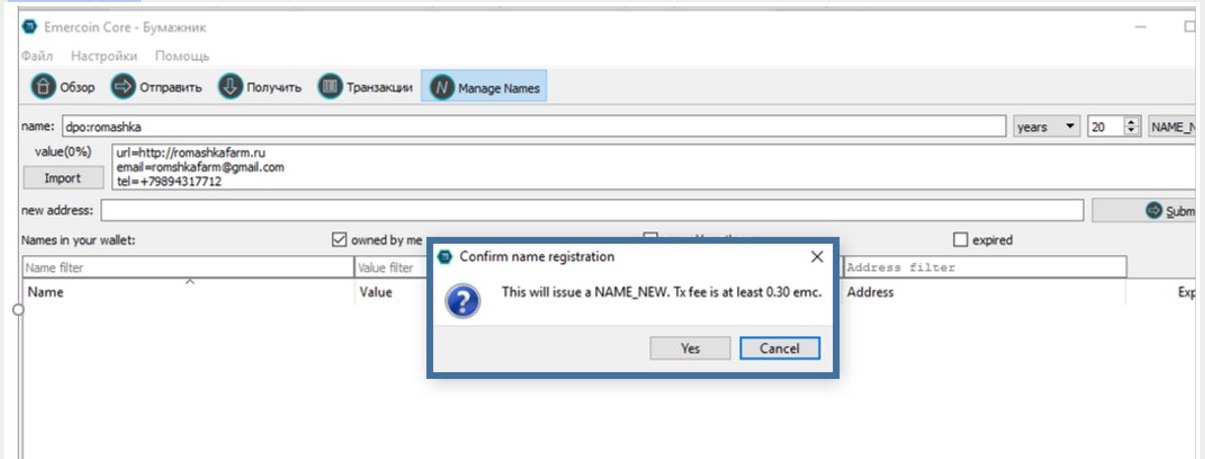
Click the “Yes” button. Information about the created entry will appear below.

Next, proceed to the creation of records of shares. This can be done in two ways: manually or using the DPO Serial number publisher program.
Method number 1 (manual input)
1. We have created a root record, now you can start creating a record of shares. It is necessary so that the fraudsters could not create a dummy share, and pass it off as legal.
First, create the name of the unit record. It must consist of a prefix - the root record (dpo :);
unique share name (organization name - Kolion, Romashka)
- digital suffix (AA01: 0)
In our case, the unit entry is as follows: dpo: Romashka: AA01: 0
Then, you go to the file tab and click the “sign a message” button

A new window should open:

In the first line we drive in the address of the record we received earlier. You can copy it from here:

And in the second we enter the created name of the share: dpo: Romashka: AA01: 0. And press the button to sign the message.

A record appears in the signature line. You will need to copy it:
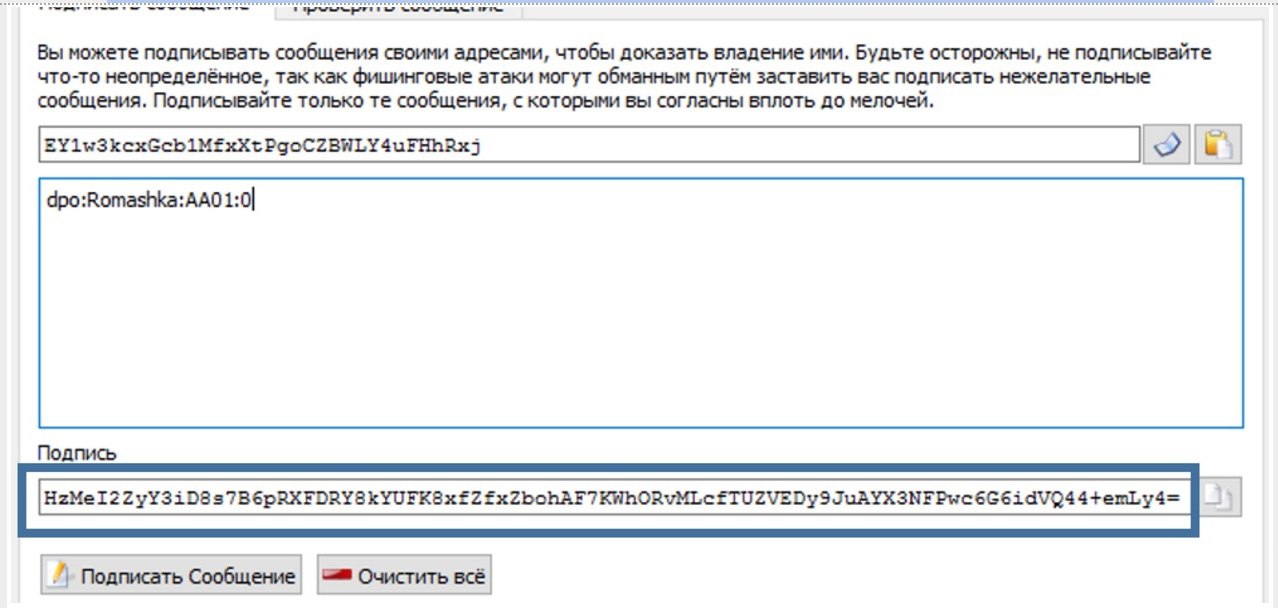
Next, we return to the “Manage Names” tab. And fill in the Name and Value fields. In the Name line, enter the new name of the unit: dpo: Romashka: AA01: 0. And in the string Value. We drive in the signature that you received when sending the message. Before signing, we write: “Signature =”.
It should look like this:
Signature = HzMeI2ZyY3iD8s7B6pRXFDRY8kYUFK8xfZfxZbohAF7KWhORvMLcfTUZVEDy9JuAYX3NFPwc6G6idVQ44 + emLy4 =
Also, do not forget to specify the lifetime of the unit record, increasing it from the standard 30 days to say 10 years (or how long you want to reserve the record). This is the input field to the right of “name”.

Then click “Submit”

The cost of registering a share is 0.07 EMC (may be different if the period of existence is extended).
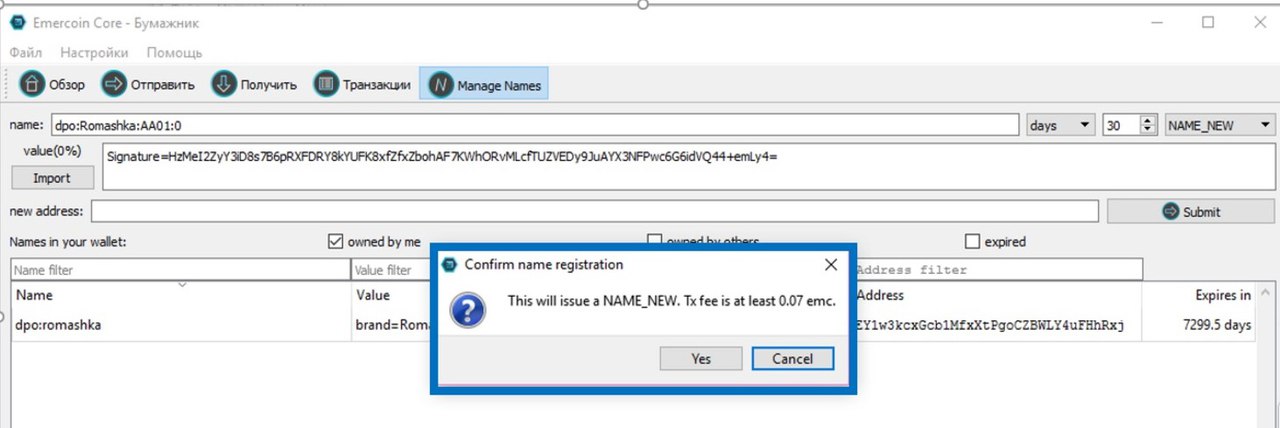
Signature registration was successful if an entry appeared below.

The final step is to verify the signature.
You need to go back to the “file” tab and click on the “check message” button.

In the window that appears, enter the name and address of the unit that you registered.

If the verification result is “true”, then the signature is correct, and there is a real share in front of you.
Special cases.
Share name captured the attacker?
It may happen that the name of the unit will be captured in advance by the attacker. He cannot recreate the signature, but may prevent you from reserving the unit with the corresponding number.
To solve this problem, there is a numeric suffix, which is usually zero (": 0"). If, say, you have discovered that the name dpo: Kolion: AA01: 0 is already taken, create another name, with a number, one more - dpo: Kolion: AA01: 1. And sign it. As a result, the attacker will remain with the untrusted name of the share, and your signed share will be trusted.
Method number 2. Record Shares with EMC SN Publiser.
1. Download the utility. To do this, click on the link: And perform the standard steps for installing the program, which is necessary for the automatic insertion of serial numbers into the Emercoin blockchain.
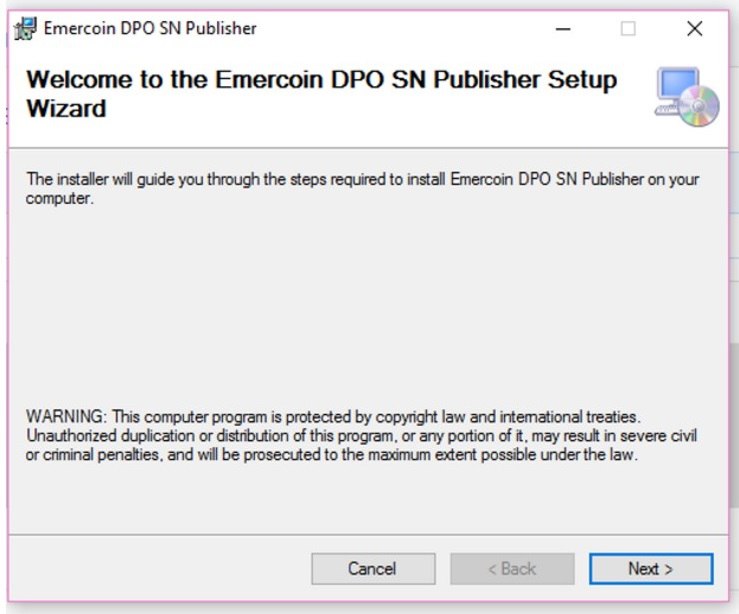
2. Prepare the CSV serial number table:
open a Microsoft Excel spreadsheet and create a new page;

In the first cell (A1) we drive in “SN”;
the remaining cells of the first row may have an arbitrary name. We added a cell called “Brend”. The prefix F in the second cell is necessary in order to protect the information with a signature. Here’s how it should look:

Then we fill these columns. SN is the serial number of your share. F-Brend is the name of your organization.

We save the filled table and import it into the CSV file format. This table is a template for reserving and signing serial numbers in the future.

3. Start and configure SN Publiser
This setting is done only once. SN Publiser automatically contacts and launches the Emercoin wallet. He will give him commands to create, sign and publish in the blockchain a huge number of entries - serial numbers associated with your products.
So, you have:
Emercoin purse with non-zero EMC coin balance
Created root DPO record (for example dpo: romashka)
Launch Emercoin DPO SN Publisher. She will automatically launch Emercoin and try to contact him.

If the launch is done for the first time, you will see this:
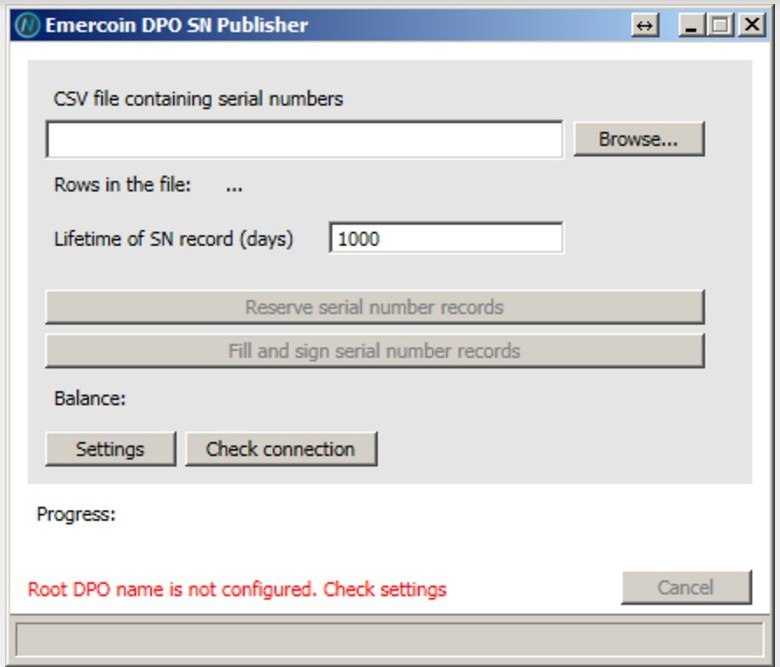
You need to specify the root DPO entry.
To do this, click the “Settings” button in the SN Publisher, a window will open. This window selects the option to connect to the Emercoin wallet. By default, the local wallet is selected, this is what we need. Then click the “Next” button.

Then a window will appear in which you must enter in the “Root DPO Name” field, enter the name of your root DPO record. (in our example, this is dpo: romashka).
You do not need to enter anything in the “Wallet passphrase” field if your Emercoin wallet is not password protected. Otherwise, you need to enter the password from the wallet. The utility will remember the password in the protected storage.
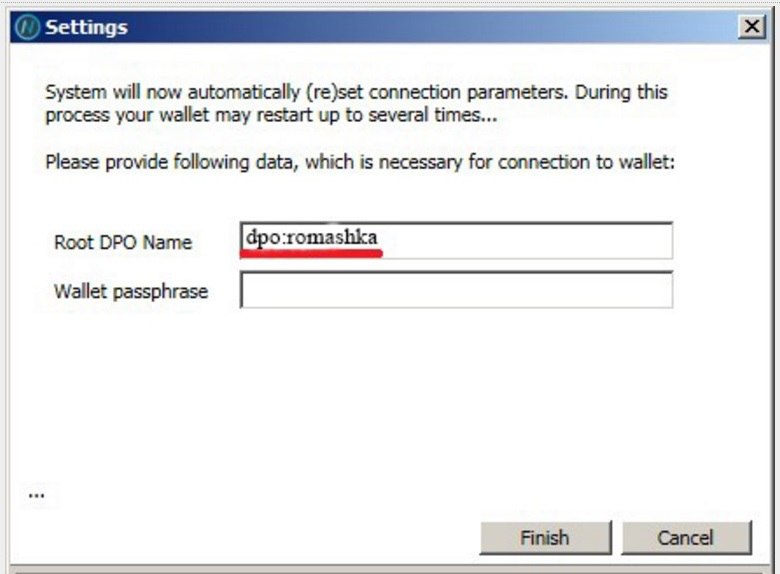
Check if you have entered everything correctly, then click the “Finish” button.
During the connection setup process, the SN Publisher utility can automatically close and restart the wallet several times.
If everything worked out, then clicking on the “Check connection” button you will see the following:

SN Publisher displays the balance of your wallet in the number of coins and displays the message “Connected to the wallet successfully”. This means that the setup is successful and you can go to the last stage.
If you have multiple DPO root entries, then you will need to reconfigure SN Publisher to work with another entry.
4. We enter the serial numbers in the blockchain by the pattern

Step 1: In SN Publiser, click “Browse ..” and select the CSV file containing the table of your serial numbers. If the table has the correct format (the separator between the columns “,”), then the number of rows in the table (the number of which corresponds to the number of serial numbers you will add to the blockchain) appears next to “Row in the file:”.
Step 2: In the “Lifetime of SN record” window, indicate for how many days your serial numbers will be reserved (by default, 1000 days).
Step 3: Use the “Reserve serial number record” button to start the process of reserving serial numbers in the blockchain. The utility accesses the Emercoin wallet and creates entries automatically. This consumes EMC coins. (0.06 EMC on recording by default). This process will take some time proportional to the number of entries made. And it will also take from 20 to 50 minutes before the Emercoin network confirms all published entries.
Step 4: If you completed the operation in step 3), and made sure that all entries were made in the blockchain, you can proceed to sign the reserved serial names. This operation is similar to the previous one and will require the same amount of time. Coins are also consumed (0.01 EMC per entry)
5. Verification
So, you have entered and signed some list of serial numbers. Now you need to make sure everything went right.
To do this, go to the site and enter into the fields: the name of the root DPO record and any serial number from the column of our CSV table.

You are now the official holder of registered shares.
6. Dividends
People invest in a project for profit, which can be expressed both in the growth of the share price and in the receipt of regular dividends. Obviously, your project is no exception. After the issue of shares and their primary sale, there is a spontaneous secondary market, when shareholders arbitrarily resell the shares to each other. Emer's blockchain mechanism provides automatic distributed notarization of ownership of units and their correct transfer between owners.
In addition, Emer allows you to send an arbitrary payment “to the share”, that is, the current owner of the unit. This opens up the possibility of automatic and cheap distribution of dividends to shareholders. It is not necessary to update the register of shareholders every time, to know their addresses, bank details or other mechanisms for the delivery of dividends. Just send a dividend to the name of a share in Emercoin, that's all. The Emergency Network itself will take care that the paid dividend is delivered to the right place.
It is very simple to send a payment “to a share” manually - in the “send” tab, instead of the Emercoin-address of the recipient we write the name of the share. The system itself will replace the name of the unit with the payment address of the current owner after your confirmation.
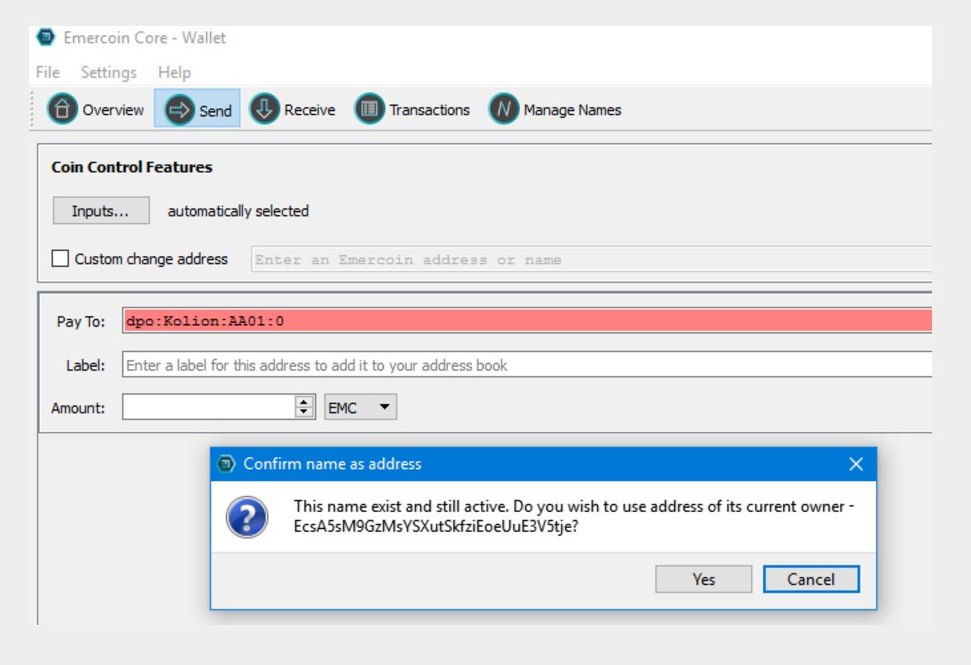
Automatic bulk payments are made by a program currently under development. Upon readiness, the program will be available for free download and unlimited use.
HashFlare cloud miner uses Emercoin technology in its work:


With blockchain, the future of agriculture is a little closer
How to explain to the farmer what a blockchain is
Imagine a big beehive: queen bee, drones, scouts, worker bees. Everyone has their own tasks, but the mission is the same: honey! As much honey as possible! Add to this scheme an observer who will record: which bee from which flower how much pollen or nectar has transferred to the hive. Time, grams, the type of flower and its location data on the meadow - everything is taken into account.
In essence, the blockchain is the same. A large database hosted on the network and accessible to a huge number of users. It is with the consent of the latter that all data is entered into the database.
In addition, once recorded information cannot be changed or erased. This system allows you to store money and important documents, track transactions and transactions, as well as independently, without intermediaries, carry out cash transactions.
')
But unlike the hive, where there is a queen and a beekeeper, there is no “upper power” in the blockchain. The interference of the state and officials is ruled out here.
Returning to our analogy, we repeat: the blockchain is a glass hive in which each portion of nectar or pollen brought by different bees is visible. But only the owner of the hive, the owner of the blockchain entry, can take the sweet honey. The main properties of this technology: publicity, distribution and mathematical accuracy. Another important detail draws attention to itself: if we talk about money transactions based on the blockchain, they are made only with the help of cryptocurrency. Doubt that cryptocurrency works for real? In vain. Details on how effective this "monetary unit" can be found here.
Why should a blockchain farmer?
Indeed ... They lived for so many years without him! But even at the splinter, they used to live, and rye was harvested without harvesters, and they also somehow managed to do without telephones. However, progress cannot be stopped, and the blockchain is gradually gaining confidence. You need it or not - decide for yourself. The possibilities of using the blockchain are endless, its functionality depends only on your imagination. The most important thing is to understand the basic principles of work and understand the advantages of using this system. We will give a few examples of the possible use of the blockchain in agriculture.
The optimal settlement system (for example, crop production)
Suppose you grow and sell seedlings of fruit, coniferous, ornamental trees, berry bushes. In most cases, sales are seasonal and take only a few months, the rest of the time is planting and caring for plants. But money is needed all the time. Using the blockchain, you can create an optimal system of settlements with customers. For example, payment upon purchase is replaced by an advance payment. Such calculation is even beneficial to the customer, because, firstly, it assumes a discount, and secondly, each installment system calculates, based on its own capabilities and in accordance with the agreement.
Buying trees and shrubs does not belong to the category of spontaneous purchases. Landscaping begins to think when they buy a plot or start building a house. Everyone understands that trees need several years to grow. Your customer can choose the necessary trees from the range offered to him, watch how they grow, paying you advance payments.
Why do we need a blockchain here? For your convenience and for the peace of mind of clients who are confident in this case that all the conditions of the order will be fulfilled. Given that you do not connect lawyers who help draw up a contract, do not take receipts that are easy to lose. You simply make a record of the transaction concluded with the client in the blockchain. This entry can be seen by all network members. Therefore, to deceive any of the parties will not succeed. The system completely eliminates dishonest transactions.
Payment terms you negotiate with the client separately. For example, you have agreed that the customer makes advance payments monthly. Then every month, at the agreed time, cryptocoins will be sent to your wallet from the client, which you will transfer to real money.
Cryptocurrency is one of the important conditions of the blockchain. When you install the blockchain on your computer, you start a virtual cryptocell.
How is the transfer of money from one wallet to another? If you compare with something familiar, then submit an email. From your mailbox you send a letter to another recipient. Now we completely eliminate the function of sending the same message to several recipients and replace the letter with a cryptocurrency. For example, user N sends to user M - 4 EMC. (EMC is a type of cryptocurrency, at the time of writing the material its cost was 11 rubles 28 kopecks)
This transaction will include two components:
The amount is the number of coins that user N sends to user M.
The output is the address of users N and M, and the time of departure.
That's all. This information is now neither deleted nor changed. Money transfer is perfect.
If you think that among your clients there is not a single person who wants to make transfers in cryptocurrency, then we can assure you that you are in a hurry with the conclusions. There is no need to go far for a real example. On the eve of the New Year, Mikhail Shlyapnikov was selling Christmas trees for the emmercoins. Depending on the breed, variety, quality and height of the tree, the price ranged from 150 to 350 EMC. An ordinary market price in rubles was taken as a basis, but with a discount, since Michal did not spend money either on the supply of Christmas trees or on sellers. The conversion to cryptocurrency occurred at the average exchange rate at the time of purchase. Buyers did not have to wait long. The demand was not joking.
New system of interaction with customers (for example, pond fish farming)
If, however, the calculation in cryptocurrency is inconvenient for you and your customers ... We offer another way to interact with customers, based on the blockchain platform. He effectively works in Kolionovo.
Mikhail Shlyapnikov on the blockchain registered 50 shares. Simplifying the explanation to customers, calls them a kind of wallets. When you purchase a wallet, you automatically receive a share of Kolionovo farm. There is one colony in this wallet - a conditional, but hard currency, invented by the farmer himself. It is not tied to the ruble or the dollar, but to a specific basket or a separate set of products.
The farmer sells these wallets for services or rubles. The cost of one wallet is 24,000 rubles.
The customer chooses, for example, the pond stocking basket and buys a wallet. The customer invests in stocking carp pond, and the farmer performs all the necessary work. Further, depending on the agreement, the client is either paid dividends from the sale of farmed fish, or the goods are given - in this case, carps. By the time the carps grow up, and the final calculation will be made. For their 24 000 rubles, the client will receive more than 100 kilograms of fresh fish! And if this amount of product he does not need? One does not eat as much, and other types of sales are not suitable for the client - what to do? As a rule, a farm has always something to offer - seedlings or potatoes, chickens, eggs, quails or milk, pork or beef, etc. Since the client is the owner of the unit, he will receive any products chosen by him twice cheaper. Profitable? Sure! A new production module is formed, which will “feed” other people - the purse owners who have invested not in stocking a pond, but in an apiary, a compound feed workshop, raising sheep or producing eggs.
Each owner of the wallet, while they are in Kolionovo 50, has fish, meat, eggs, milk, and vegetables. According to Mikhail Shlyapnikov, only six months have passed since the project started working in real mode, and it turned out that the cost of production has sharply decreased. This allowed to provide customers with substantial discounts (up to 40%), while not going beyond the framework of profitability.
New system of interaction with customers (for example, the grocery basket)
Is it possible to apply the same system of shares without expanding your farm? Suppose you have a small agricultural production: two cows, a dozen hens, a few rabbits. You sell eggs, milk, sour cream, yogurt, sometimes meat. Expand their possessions do not want or can not for some reason (lack of large territory or labor). Instead of several baskets offered by Michael, you can stop at one - grocery. Act in the same way. Register in the blockchain unit wallets, the number that you deem necessary. Sell them for rubles. For example, your wallet will cost 30,000 rubles. For this amount you provide your customers with a grocery basket that includes: two hundred eggs, ten liters of milk, 5 liters of yogurt, 4 rabbits. This basket client can receive a one-time, or to stretch the receipt of products for a whole year.
Sale of assets on the cryptocurrency exchange (for example, winemaking)
The proposed use of the blockchain by Mikhail Shlyapnikov came up with quite recently.
Suppose you live in the Krasnodar Territory, Dagestan, Georgia, France ... Where weather conditions allow you to grow grapes and produce wine. Planting and harvesting, preparing pulp and wort ... - the technology of your work remains unchanged, but now you supply each barrel or bottle with an individual certificate and a QR code. Photograph and send to the cellar. Then make an entry in the blockchain, release the asset and place it at the starting price on a cryptocurrency exchange. Michael called such assets alco-colonies.
Why do you need it? The fact is that derivatives based on cryptocurrency are in great demand now. Traders will use your asset as a speculative derivative. A derivative is a tool that allows investors or traders to trade an asset indirectly - that is, not by the asset itself, but by any kind of obligations to transfer it or value units created on its basis, in our case, the obligation to transfer wine. The most common derivative is futures. This is a contract for the purchase of goods in the future, at a price that has already been established. This allows the buyer to insure against excessive price increases - but it means additional costs in the event that prices for goods decrease. But you as a manufacturer are not interested in the rise or decline of prices, since you are lining up in the starting amount all the costs that you will have to spend.
Sale of assets on the cryptocurrency exchange (for example, breeding geese)
In the same way, it is possible to produce assets for breeding geese, rams or rabbits. For example, you make an entry in the blockchain and release assets for the purchase of geese in 2018. With the money received from the sale of assets you buy eggs, animal feed, pay for the light, materials, repair the roaster, and by 2018 you will already be ready to give the geese.
And what exactly do you need to do?
First, be patient. Any innovation is always difficult. Worldwide, large manufacturing and small enterprises, central banks, young startups and farms are choosing blockchain as the fundamental basis of their own business.
Secondly, you need to decide which of the functional solutions of the blockchain is necessary for your business. We have listed only a few examples of using Emercoin blockchain in agriculture. You can apply them all or come up with something of your own - blockchain technology is multifunctional.
If you decide to register the shares on the blockchain, then we offer you step-by-step instructions. First you need to understand that registration of units requires a special DPO-record. What it is? A DPO record is a record of a unique name on the blockchain, signed by another name, hereinafter referred to as “root”. For example, the root is the name "dpo: Kolion", which is owned by Mikhail Shlyapnikov.
By signing with this name the units of his household, he certifies that it was he who released them, and no one else.
Understanding is, great. Getting to work.
1. Download and install Emercoin wallet. This can be done on the official website of Emercoin, by going to the wallet-download tab. Downloading and installing the wallet is literally two clicks, so it does not take much time.


After downloading the wallet. Perform standard program requests.

It will take a little time for the wallet to synchronize with the network.

2. Next, you need to replenish the wallet cryptocurrency. To do this, go to one of the many exchanges and exchange real money for EMC coins. For example, this can be done on the exchange: LiveCoin, or on any exchange from this list. You can also ask for some coins from the Emercoin team.
To get the initial shares you need no more than 10 EMC. Translated into rubles, this is a little more than 120 rubles.
3. Then proceed to create the root record. Open the wallet and find the tab "Manage Names" in the wallet.

Create a new root name with the service prefix "dpo:". For example, the name “dpo: Kolion” was created for the agricultural enterprise “Kolionovo”, and for the “Rocket” watch factory “dpo: Raketa”. You need to insert the name of your organization in the name line. As an example, we will call our agricultural enterprise “Romashka”.

Next we fill in the value field. In it we enter any information that we want to report about the company. The information must be entered in the format of several lines: key = value, where key is the explanation of what data you enter (phone, mail, website, etc.), and the value information itself.
For example:
brand = Romashka farm Enter the name of your organization on this line.
url = http: //romashkafarm.ru This line is for your website, if there is no website, then delete this line. Bottom lines respectively for email and phone
email=romshkafarm@gmail.com
tel = + 79894317712
You can also enter any other information.

Then make changes in the upper right corner. Instead of the value of days, choose years, that is, change the days for years. And we put the number 20 or 25. This data means the validity term of the name (rental period of the record). Subsequently, it can be extended, but the name must always be active, that is, not expired.

If you have entered all the data, you must click on the submit button.

After clicking the window will appear. The program will ask you: “are you sure that you want to create a root record and are you ready to spend 0.3 EMC”.

Click the “Yes” button. Information about the created entry will appear below.

Next, proceed to the creation of records of shares. This can be done in two ways: manually or using the DPO Serial number publisher program.
Method number 1 (manual input)
1. We have created a root record, now you can start creating a record of shares. It is necessary so that the fraudsters could not create a dummy share, and pass it off as legal.
First, create the name of the unit record. It must consist of a prefix - the root record (dpo :);
unique share name (organization name - Kolion, Romashka)
- digital suffix (AA01: 0)
In our case, the unit entry is as follows: dpo: Romashka: AA01: 0
Then, you go to the file tab and click the “sign a message” button

A new window should open:

In the first line we drive in the address of the record we received earlier. You can copy it from here:

And in the second we enter the created name of the share: dpo: Romashka: AA01: 0. And press the button to sign the message.

A record appears in the signature line. You will need to copy it:

Next, we return to the “Manage Names” tab. And fill in the Name and Value fields. In the Name line, enter the new name of the unit: dpo: Romashka: AA01: 0. And in the string Value. We drive in the signature that you received when sending the message. Before signing, we write: “Signature =”.
It should look like this:
Signature = HzMeI2ZyY3iD8s7B6pRXFDRY8kYUFK8xfZfxZbohAF7KWhORvMLcfTUZVEDy9JuAYX3NFPwc6G6idVQ44 + emLy4 =
Also, do not forget to specify the lifetime of the unit record, increasing it from the standard 30 days to say 10 years (or how long you want to reserve the record). This is the input field to the right of “name”.

Then click “Submit”

The cost of registering a share is 0.07 EMC (may be different if the period of existence is extended).

Signature registration was successful if an entry appeared below.

The final step is to verify the signature.
You need to go back to the “file” tab and click on the “check message” button.

In the window that appears, enter the name and address of the unit that you registered.

If the verification result is “true”, then the signature is correct, and there is a real share in front of you.
Special cases.
Share name captured the attacker?
It may happen that the name of the unit will be captured in advance by the attacker. He cannot recreate the signature, but may prevent you from reserving the unit with the corresponding number.
To solve this problem, there is a numeric suffix, which is usually zero (": 0"). If, say, you have discovered that the name dpo: Kolion: AA01: 0 is already taken, create another name, with a number, one more - dpo: Kolion: AA01: 1. And sign it. As a result, the attacker will remain with the untrusted name of the share, and your signed share will be trusted.
Method number 2. Record Shares with EMC SN Publiser.
1. Download the utility. To do this, click on the link: And perform the standard steps for installing the program, which is necessary for the automatic insertion of serial numbers into the Emercoin blockchain.

2. Prepare the CSV serial number table:
open a Microsoft Excel spreadsheet and create a new page;

In the first cell (A1) we drive in “SN”;
the remaining cells of the first row may have an arbitrary name. We added a cell called “Brend”. The prefix F in the second cell is necessary in order to protect the information with a signature. Here’s how it should look:

Then we fill these columns. SN is the serial number of your share. F-Brend is the name of your organization.

We save the filled table and import it into the CSV file format. This table is a template for reserving and signing serial numbers in the future.

3. Start and configure SN Publiser
This setting is done only once. SN Publiser automatically contacts and launches the Emercoin wallet. He will give him commands to create, sign and publish in the blockchain a huge number of entries - serial numbers associated with your products.
So, you have:
Emercoin purse with non-zero EMC coin balance
Created root DPO record (for example dpo: romashka)
Launch Emercoin DPO SN Publisher. She will automatically launch Emercoin and try to contact him.

If the launch is done for the first time, you will see this:

You need to specify the root DPO entry.
To do this, click the “Settings” button in the SN Publisher, a window will open. This window selects the option to connect to the Emercoin wallet. By default, the local wallet is selected, this is what we need. Then click the “Next” button.

Then a window will appear in which you must enter in the “Root DPO Name” field, enter the name of your root DPO record. (in our example, this is dpo: romashka).
You do not need to enter anything in the “Wallet passphrase” field if your Emercoin wallet is not password protected. Otherwise, you need to enter the password from the wallet. The utility will remember the password in the protected storage.

Check if you have entered everything correctly, then click the “Finish” button.
During the connection setup process, the SN Publisher utility can automatically close and restart the wallet several times.
If everything worked out, then clicking on the “Check connection” button you will see the following:

SN Publisher displays the balance of your wallet in the number of coins and displays the message “Connected to the wallet successfully”. This means that the setup is successful and you can go to the last stage.
If you have multiple DPO root entries, then you will need to reconfigure SN Publisher to work with another entry.
4. We enter the serial numbers in the blockchain by the pattern

Step 1: In SN Publiser, click “Browse ..” and select the CSV file containing the table of your serial numbers. If the table has the correct format (the separator between the columns “,”), then the number of rows in the table (the number of which corresponds to the number of serial numbers you will add to the blockchain) appears next to “Row in the file:”.
Step 2: In the “Lifetime of SN record” window, indicate for how many days your serial numbers will be reserved (by default, 1000 days).
Step 3: Use the “Reserve serial number record” button to start the process of reserving serial numbers in the blockchain. The utility accesses the Emercoin wallet and creates entries automatically. This consumes EMC coins. (0.06 EMC on recording by default). This process will take some time proportional to the number of entries made. And it will also take from 20 to 50 minutes before the Emercoin network confirms all published entries.
Step 4: If you completed the operation in step 3), and made sure that all entries were made in the blockchain, you can proceed to sign the reserved serial names. This operation is similar to the previous one and will require the same amount of time. Coins are also consumed (0.01 EMC per entry)
5. Verification
So, you have entered and signed some list of serial numbers. Now you need to make sure everything went right.
To do this, go to the site and enter into the fields: the name of the root DPO record and any serial number from the column of our CSV table.

You are now the official holder of registered shares.
6. Dividends
People invest in a project for profit, which can be expressed both in the growth of the share price and in the receipt of regular dividends. Obviously, your project is no exception. After the issue of shares and their primary sale, there is a spontaneous secondary market, when shareholders arbitrarily resell the shares to each other. Emer's blockchain mechanism provides automatic distributed notarization of ownership of units and their correct transfer between owners.
In addition, Emer allows you to send an arbitrary payment “to the share”, that is, the current owner of the unit. This opens up the possibility of automatic and cheap distribution of dividends to shareholders. It is not necessary to update the register of shareholders every time, to know their addresses, bank details or other mechanisms for the delivery of dividends. Just send a dividend to the name of a share in Emercoin, that's all. The Emergency Network itself will take care that the paid dividend is delivered to the right place.
It is very simple to send a payment “to a share” manually - in the “send” tab, instead of the Emercoin-address of the recipient we write the name of the share. The system itself will replace the name of the unit with the payment address of the current owner after your confirmation.

Automatic bulk payments are made by a program currently under development. Upon readiness, the program will be available for free download and unlimited use.
HashFlare cloud miner uses Emercoin technology in its work:

Source: https://habr.com/ru/post/402205/
All Articles